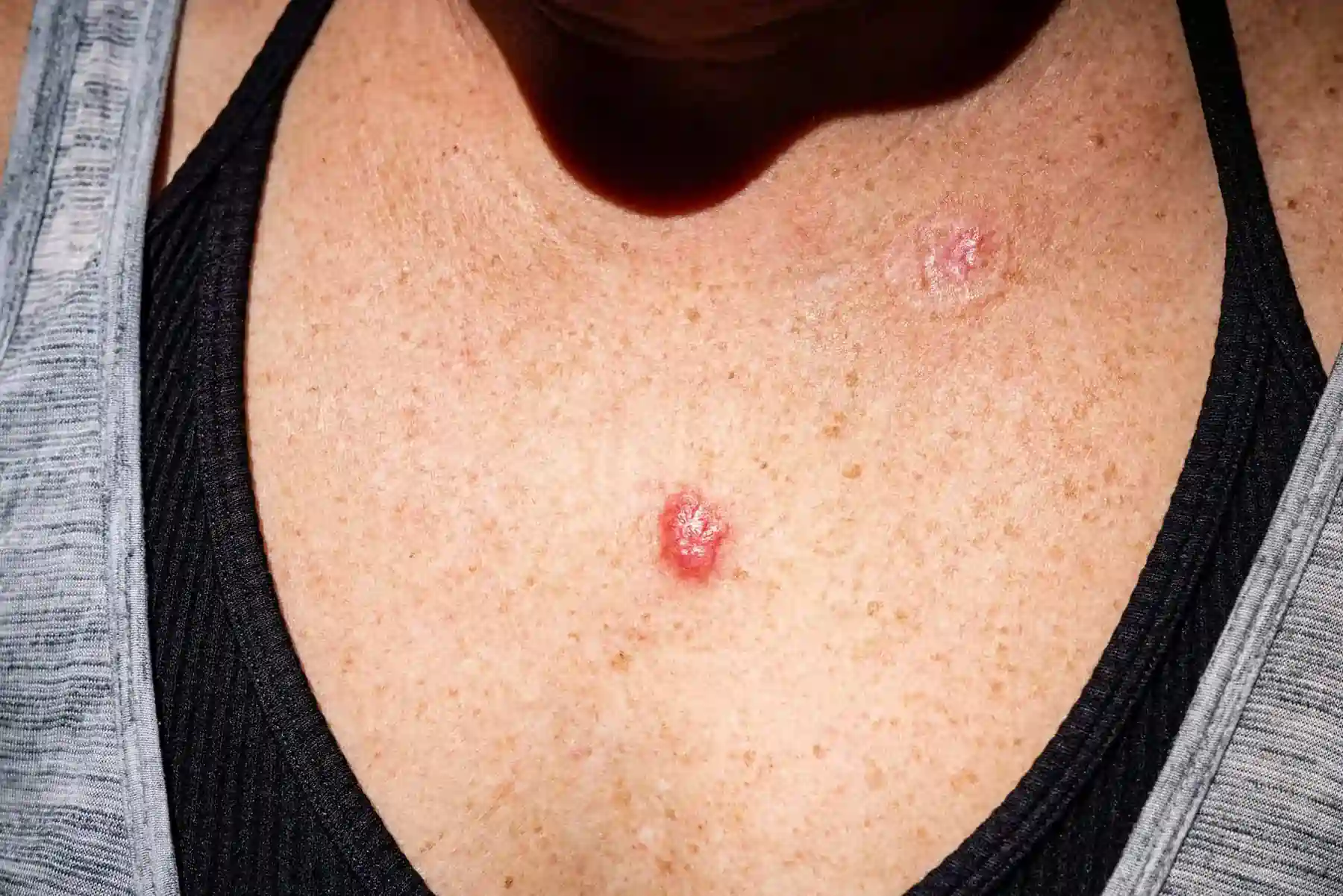Squamous Cell Carcinoma in New York, NY

Squamous Cell Carcinoma in New York, NY
Squamous Cell Carcinoma (SCC) is the most prevalent type of skin cancer originating in the squamous cells, which comprise the middle and outer layers of the skin. While it most often develops on sun-exposed areas such as the face, ears, neck, and hands, it can also appear in other regions, including the mouth, esophagus, and lungs. SCC symptoms typically include rough, scaly patches, open sores, or wart-like growths that may crust over, bleed, or not heal. Early signs of skin cancer like these should not be ignored, as Squamous Cell Carcinoma is capable of spreading to other parts of the body, making early diagnosis and treatment critical.
What Causes Squamous Cell Carcinoma?
Squamous Cell Carcinoma is primarily caused by excessive exposure to ultraviolet (UV) radiation from the sun or tanning beds. This exposure damages the DNA in the skin cells, which can cause them to grow uncontrollably. Other risk factors include fair skin, sunburns, exposure to radiation, weakened immune systems, and a history of skin cancer.
Key Causes and Risk Factors for Squamous Cell Carcinoma include
Ultraviolet (UV) Radiation
The primary cause of Squamous Cell Carcinoma is excessive exposure to ultraviolet (UV) radiation from the sun or tanning beds. This exposure damages the DNA in skin cells, leading to abnormal cell growth.
Fair Skin
Those with fair skin have a greater risk of developing Squamous Cell Carcinoma because they have less melanin, which provides some protection against UV radiation.
Sunburns
Repeated sunburns, especially during childhood, significantly increase the risk of Squamous Cell Carcinoma later in life.
Radiation Exposure
Having been exposed to radiation in the past, such as radiation therapy for other cancers, can increase the likelihood of developing Squamous Cell Carcinoma.
Weakened Immune System
Individuals with impaired immune systems, such as organ transplant recipients or those with certain medical conditions, are at a higher risk of developing Squamous Cell Carcinoma.
History of Skin Cancer
A personal or family history of skin cancer increases the chances of developing Squamous Cell Carcinoma.
What Are the Different Procedures for Squamous Cell Carcinoma?
Surgical Excision
The procedure involves cutting out the Squamous Cell Carcinoma and a margin of healthy skin to remove all cancerous cells. It is often used for easily accessible tumors.
Mohs Surgery for SCC
Mohs surgery is a precise technique where layers of cancer-containing skin are carefully removed and examined until only cancer-free tissue remains. This procedure is highly effective, especially for head and neck cancer or areas requiring tissue conservation.
Cryotherapy
This treatment involves freezing the Squamous Cell Carcinoma with liquid nitrogen, causing the cancer cells to die. It is generally used for smaller, superficial cancers.
Radiation Therapy
Radiation uses high-energy rays to kill cancer cells. It is often used for patients who cannot undergo surgery or when the SCC is located in areas that are difficult to treat surgically.
Topical Medications
Creams or gels containing cancer-fighting agents can be applied directly to the Squamous Cell Carcinoma. This is typically reserved for superficial cases.
Chemotherapy and Immunotherapy
In cases where SCC has spread beyond the skin, systemic treatments like chemotherapy or immunotherapy may be necessary. These treatments work throughout the entire body to target cancer cells.
What Are the Results?
The outcome of squamous cell carcinoma treatment varies depending on the stage and location of the cancer. Early-stage SCC is often highly treatable and has an excellent prognosis when addressed promptly. Surgical methods, particularly Mohs surgery, have high success and low recurrence rates. However, if SCC is not treated early, it may spread to other body parts, complicating treatment and reducing the chance of a favorable outcome. Regular follow-ups are crucial for monitoring and skin cancer prevention.
Benefits of Squamous Cell Carcinoma Treatment include
- Early detection and removal of cancerous cells
- High success rates with surgical excision and Mohs surgery for SCC
- Minimally invasive options like cryotherapy and topical medications
- Preservation of healthy tissue, particularly in sensitive areas
- Reduced risk of cancer spread to other organs
- Improvement in cosmetic appearance post-treatment
- Customizable treatment plans based on individual needs
- Access to advanced systemic treatments for metastatic SCC
- Prevention of further complications related to SCC
- Professional follow-up care for ongoing skin cancer prevention
Frequently Asked Questions
Squamous Cell Carcinoma is more likely to develop in individuals with prolonged sun exposure, a history of frequent sunburns, use of tanning beds, fair skin, a weakened immune system, and a personal or family history of skin cancer.
Diagnosis generally involves a physical examination of the skin and a biopsy of the suspicious area. The biopsy is analyzed under a microscope to confirm the presence of cancerous cells.
While squamous cell carcinoma is generally treatable when caught early, it can become life-threatening if it spreads to other parts of the body. This underscores the relevance of early detection and treatment.
Recovery time varies based on the treatment technique used. Surgical excision and Mohs surgery typically require a few weeks for complete healing, while treatments like radiation or systemic therapies may involve more extended recovery periods.
Yes, squamous cell carcinoma can recur, especially if not all cancerous cells are removed. Regular check-up visits with your dermatologist are essential to monitor for any signs of recurrence.
Preventing Squamous Cell Carcinoma involves sun protection tips such as using sunscreen, wearing protective clothing, avoiding tanning beds, and frequently checking your skin for any changes. Early detection through routine skin checks is also crucial.
